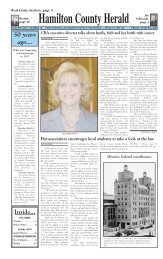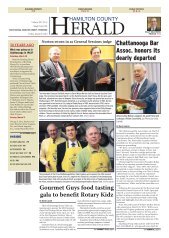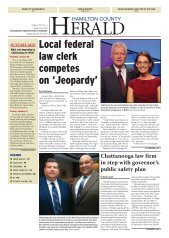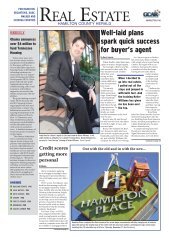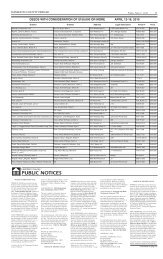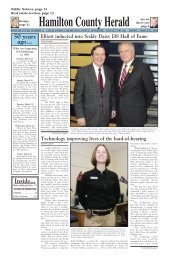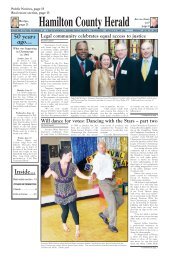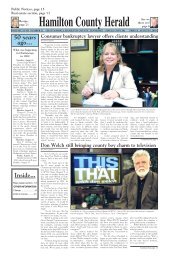50 years ago... Inside... - Chattanooga Bar Association
50 years ago... Inside... - Chattanooga Bar Association
50 years ago... Inside... - Chattanooga Bar Association
You also want an ePaper? Increase the reach of your titles
YUMPU automatically turns print PDFs into web optimized ePapers that Google loves.
10 Friday, February 20, 2009 HAMILTON COUNTY HERALD<br />
Civil liberties seek to require warrants for GPS surveillance<br />
A diverse group of civil liberties<br />
and religious organizations this week<br />
weighed in on the question of<br />
whether police need a warrant in<br />
order to conduct surveillance of personal<br />
vehicles by secretly attaching<br />
global positioning satellite (GPS)<br />
transmitters. The case, which is<br />
scheduled to be heard next month in<br />
New York’s highest court, has profound<br />
implications for the privacy<br />
rights of individuals and organizations.<br />
Low-cost GPS transmitters can<br />
be secretly attached to a vehicle and<br />
pinpoint the vehicle’s location on<br />
public or private property, within a<br />
few feet or yards, to virtually any<br />
computer with an Internet connection.<br />
The devices are useful for tracking<br />
a vehicle or person in real-time,<br />
but the data also can be permanently<br />
stored and subjected to pattern analysis,<br />
revealing not just a person’s<br />
whereabouts, but his habits, associa-<br />
AT FIRST BLUSH, IT<br />
FEELS LIKE LOVE<br />
Dear Amy: Around seven<br />
months <strong>ago</strong>, I met “Brian.”<br />
He’s smart, funny and sweet.<br />
He respects me (although he<br />
occasionally jokes about the fact<br />
that I am a lot shorter than he<br />
is), and we have fun together.<br />
Sounds perfect, right?<br />
Wrong. Here’s the problem: I’m<br />
only 14. He’s 16.<br />
I truly feel as if I’m in love<br />
with him. I can’t stop thinking<br />
about him, and whenever his<br />
name is mentioned, I start blushing<br />
out of control. I’ve had<br />
crushes before, but this one is<br />
way more than a simple crush.<br />
Do you think 14 is too<br />
young to find love? —Crushed<br />
Out<br />
Dear Crushed: I don’t think<br />
that 14 is too young to find love,<br />
but I do think that 14 is too<br />
young to have love.<br />
I’m an old crank when it<br />
comes to love. Love is a wonder-<br />
tions, who his friends are, where he<br />
shops, banks and goes to church, and<br />
a host of other information. The<br />
coalition argues that court supervision<br />
should be required to protect<br />
First and Fourth Amendment privacy<br />
rights.<br />
In People v. Weaver, scheduled<br />
for argument in the New York Court<br />
of Appeals March 24, the court will<br />
be considering whether a police officer,<br />
in his own discretion, may undertake<br />
GPS surveillance of individuals<br />
without any judicial oversight at all.<br />
The court below held that there is no<br />
obligation to obtain a warrant prior<br />
to undertaking such monitoring.<br />
Members of the public have no way<br />
of knowing if their movements are<br />
subject to electronic surveillance<br />
from which there is no legal protection.<br />
The civil liberties alliance filed<br />
an amicus curiae, or “friend of the<br />
court,” brief arguing such unfettered<br />
ful terminus at the end of a<br />
whole series of choices and experiences.<br />
At your age, you shouldn’t<br />
even be at the starting gate<br />
— you should be going to the<br />
multiplex with your friends, and<br />
love should be in the far-off distance.<br />
You’re going to read<br />
Shakespeare one of these days<br />
and declare me to be all wrong.<br />
The story of the adolescent<br />
lovers in “Romeo and Juliet” is<br />
often offered up as an example of<br />
perfect teen love.<br />
But Romeo and Juliet hardly<br />
knew each other, just as you<br />
and your wonderful guy hardly<br />
know each other.<br />
Take your time. Enjoy these<br />
feelings. Make sure you and<br />
“Brian” are always nice to each<br />
other. But don’t jump into love.<br />
Dear Amy: My boyfriend of<br />
less than a year has decided to<br />
quit smoking, mostly because I<br />
hate it.<br />
He went on a prescription<br />
surveillance is unconstitutional and<br />
ill-advised as a matter of public policy.<br />
The groups include the National<br />
<strong>Association</strong> of Criminal Defense<br />
Lawyers (NACDL), the New York<br />
State <strong>Association</strong> of Criminal<br />
Defense Lawyers, the New York<br />
State Defenders <strong>Association</strong>, the<br />
Electronic Frontier Foundation, the<br />
American-Arab Anti-<br />
Discrimination Committee, the Sikh<br />
American Legal Defense and<br />
Education Fund, the Council on<br />
American-Islamic Relations, and the<br />
Union for Reform Judaism. They<br />
urge the court to condition GPS<br />
monitoring upon judicial issuance of<br />
a warrant.<br />
The brief was written by Susan<br />
J. Walsh, a partner at Moskowitz,<br />
Book & Walsh, LLP in New York<br />
City, NACDL Executive Director<br />
Norman L. Reimer and NACDL<br />
Assistant Director of Public Affairs &<br />
pill that cuts the craving. So far<br />
it’s been a couple of weeks and<br />
it’s working to cut his craving,<br />
but a side effect is that he is now<br />
constantly angry at me.<br />
When I try to cheer him up<br />
and tell him how proud I am of<br />
him, he seems to get mad at<br />
that!<br />
This is hard. For one thing,<br />
it’s a new relationship and I<br />
haven’t seen him angry with me<br />
before. And although I don’t like<br />
this new behavior, I still want<br />
him to quit smoking.<br />
This also comes at a time<br />
when I am having some family<br />
issues, and I really want my<br />
boyfriend to be there for me<br />
emotionally, but he has been<br />
withdrawn.<br />
I want to be sympathetic to<br />
what either this pill or the nicotine<br />
withdrawal is doing to him,<br />
but it’s hard for me to be 100 percent<br />
supportive when I’m not<br />
feeling support from him, though<br />
we have both made it clear that<br />
we want to keep our relationship<br />
going.<br />
How do you think I should<br />
handle this? —Struggling to<br />
Stay Strong<br />
Dear Struggling: Aside from<br />
any side effects and withdrawal<br />
symptoms your boyfriend might<br />
still be experiencing, he proba-<br />
Communications Ivan J.<br />
Dominguez.<br />
“By its nature, GPS is a valuable<br />
tool because it permits long-term,<br />
sustained surveillance. But its potential<br />
for abuse is staggering. To allow<br />
this kind of personal data collection<br />
without judicial oversight is an<br />
Orwellian nightmare. The minimal<br />
time required to obtain a warrant<br />
based on probable cause restores balance<br />
and cannot credibly be said to<br />
impede legitimate law enforcement<br />
objectives,” explains lead counsel<br />
Susan J. Walsh.<br />
A dissenting opinion in the case<br />
rejected the analogy that the use of<br />
GPS is the functional equivalent of<br />
being followed by the police on public<br />
roads. Relying upon the search<br />
and seizure provisions of New York<br />
State’s Constitution, the dissent concluded<br />
that “while the citizens of this<br />
state may not have a reasonable<br />
bly would feel better if he<br />
stopped smoking not for you, but<br />
for himself.<br />
His choice to stop smoking<br />
for you means that he is less likely<br />
to stay on the w<strong>ago</strong>n, because<br />
you can’t be around all the time<br />
to cheer for him or absorb his<br />
bad moods.<br />
I suggest you drop this topic<br />
entirely. Trust that your guy is<br />
struggling, help him if he asks,<br />
but otherwise stay away from his<br />
choice to smoke — or not<br />
smoke.<br />
He should see the person<br />
who prescribed his medication<br />
to double-check the side effects.<br />
It might be best to step down the<br />
dosage and move on to another<br />
method of kicking his habit.<br />
You have a right to expect<br />
your boyfriend to be decent to<br />
you, even when he’s in a foul<br />
“wish-I-had-a-cigarette” mood.<br />
It’s time to tell him that. If he<br />
chooses to resume smoking and<br />
you can’t bear it, then you will<br />
have some decisions to make.<br />
Dear Amy: Recently a<br />
neighbor installed some kind of<br />
generator or hot tub, and the<br />
motor produces an almost constant<br />
and noticeable hum in our<br />
backyard.<br />
Because it is winter, I<br />
haven’t tried to find out what<br />
expectation of privacy in a public<br />
place at any particular moment, they<br />
do have a reasonable expectation<br />
that their every move will not be<br />
continuously and indefinitely monitored<br />
by a technical device without<br />
their knowledge, except where a warrant<br />
has been issued based on probable<br />
cause.”<br />
According to Norman Reimer,<br />
the executive director of NACDL,<br />
“Permitting unlimited, around-theclock,<br />
uninterrupted 24/7 monitoring<br />
of an individual’s whereabouts is<br />
as much a First Amendment issue as<br />
it is a Fourth Amendment issue.” He<br />
points out that “the government can<br />
learn where a person worships, what<br />
clubs they attend, what political parties<br />
they participate in, where they<br />
sleep, and other personal and private<br />
information completely irrelevant to<br />
legitimate law enforcement needs.”<br />
Source: NACDL ❖<br />
Commentary: Ethical considerations in leveraging demonstratives<br />
by Daniel Wolfe and Lance Johnson<br />
The Daily Record Newswire<br />
Using demonstratives to tell a<br />
story during trial can be critical to<br />
the success of a case. Employing a<br />
multi-modal presentation strategy,<br />
one that coordinates both visual and<br />
auditory elements, can immeasurably<br />
increase the persuasive impact<br />
of your case for two reasons.<br />
First, multiple communication<br />
channels enhance jurors’ working<br />
memory capacity, which ultimately<br />
increases retention of the information<br />
presented.<br />
Second, because most jurors<br />
rely predominantly on their visual<br />
learning abilities when processing<br />
new information, visual imagery<br />
enables jurors to better absorb and<br />
comprehend facts and circumstances.<br />
While this approach is highly<br />
effective, the use of a visual strategy<br />
that includes demonstratives, graphics,<br />
illustrations and/or animations<br />
raises important ethical considerations<br />
when leveraging these mechanisms<br />
as persuasion tools.<br />
How do jurors, lawyers and the<br />
judiciary perceive the duties of candor<br />
and accurate representation of<br />
the evidence? What factors enhance<br />
the effectiveness and admissibility of<br />
graphic and demonstrative evidence?<br />
This article will aid lawyers to<br />
advocate zealously within the<br />
bounds of common sense and decency<br />
and provide steps for maximizing<br />
the impact and use of demonstrative<br />
exhibits at trial, arbitration, mediation<br />
and other advocacy settings.<br />
Jurors’ learning styles<br />
The concept of “learning styles”<br />
suggests there is no one best way to<br />
educate every person. Instead, people<br />
are presumed to have different<br />
strengths and preferences concerning<br />
the manner in which they perceive,<br />
process and retain information.<br />
Several models have proposed<br />
various ways to describe the learning<br />
styles concept, suggesting that people<br />
tend to represent information primarily<br />
as words or as images, and that<br />
people vary in terms of which modality<br />
induces them to learn most optimally<br />
(i.e., visual, auditory or kinesthetic<br />
- touch).<br />
Not surprisingly, 29 percent of<br />
American adults rank at the “basic”<br />
level of literacy (able to perform only<br />
simple and everyday literacy activi-<br />
Ask Amy<br />
Advice for the Real World<br />
By Amy Dickinson, Tribune Media<br />
ties); 14 percent rank as “below<br />
basic”; and only 13 percent rank as<br />
“proficient” at performing complex<br />
and challenging literacy activities.<br />
Put another way, most jurors on your<br />
jury spend far more time consulting<br />
their “visual sketch pad” than their<br />
“verbal diary.”<br />
The bottom line is that visual<br />
images, rather than words, dominate<br />
most people’s thinking, and visual<br />
images are the modality through<br />
which most people are most comfortable<br />
and best able to learn.<br />
Ethical obligations<br />
Lawyers have ethical duties of<br />
candor and to represent the facts<br />
accurately when using demonstrative<br />
evidence. As a practical matter,<br />
lawyers are often left to rely on their<br />
own sense of decency and common<br />
sense.<br />
Understandably, there must be<br />
a balance between persuasion and<br />
prejudice; the exhibit must be probative<br />
of a fact in issue without being<br />
unduly biased. In this regard, information<br />
design techniques relating to<br />
aesthetic appeal and persuasion<br />
come into play.<br />
Among other things, these<br />
considerations include scaling techniques,<br />
icons and color. The key is to<br />
make sure that creativity doesn’t<br />
come at the expense of accuracy or<br />
by misrepresenting the evidence.<br />
One of the most important<br />
issues to consider is scaling. Often<br />
times, counsel has to present data to<br />
the trier of fact in a table or chart. <strong>Bar</strong><br />
charts are a common method to<br />
illustrate such information. Scale<br />
always comes into play when designing<br />
bar charts. The y-axis in particular<br />
can be used to accentuate or minimize<br />
the data depending on how the<br />
graphic is designed.<br />
For example, two charts can<br />
incorporate the same data and show<br />
the change of sales from $900,000 in<br />
one month to $855,000 in the next.<br />
However, one can vary the scaling<br />
range on the y-axis to impact dramatically<br />
the immediate message<br />
that is reflected; specifically, the first<br />
chart can illustrate an impressive<br />
drop-off from one month to the<br />
next, whereas the second suggests<br />
that the sales were fairly consistent<br />
from a month-to-month basis.<br />
Although both are accurate, scale<br />
radically affects the visual message of<br />
these two charts.<br />
Another graphic design element<br />
that is important to consider is<br />
whether to use icons. Icons are<br />
ingrained in our day-to-day lives and<br />
for a good reason. While words can<br />
be quite informative and helpful,<br />
they can also be visually limiting or<br />
confusing. Icons are a powerful<br />
CliffsNotes version of ideas, events,<br />
objects and much more.<br />
Icons allow you to define a concept<br />
visually without the need for<br />
words. Beyond being an economic<br />
form of communication, icons are<br />
also effective because they can convey<br />
points that would otherwise<br />
necessitate a lengthy explanation,<br />
and together they can construct a<br />
pattern that the eye is more likely to<br />
identify than if it were viewing text<br />
alone.<br />
For instance, suppose you are<br />
the defense and are presenting an<br />
opening argument for a personal<br />
injury case involving a plaintiff who<br />
had dozens of doctor’s visits prior to<br />
the accident at issue. Rather than<br />
identifying each of the doctor’s visits<br />
with text, it would be far more visually<br />
effective to use a medical cartouche<br />
icon to represent each visit.<br />
The repeated pattern will make the<br />
graphic more powerful than text<br />
alone.<br />
Continued on page 11<br />
the source of the noise is, but I<br />
spend a lot of time outdoors, and<br />
we sleep with our windows open<br />
in the summer and the hum is<br />
disturbing.<br />
How do I approach<br />
whichever neighbor it is to talk<br />
about this? —Karen in Oregon<br />
Dear Karen: First you need<br />
to try to identify the source of<br />
the noise. Then contact your<br />
neighbors, assuming they aren’t<br />
aware of the imposition. The<br />
sooner you do this, the more<br />
time they will have to try to muffle<br />
the noise. If they don’t rectify<br />
the situation, then research your<br />
local noise ordinance to see if<br />
they might be in violation.<br />
If this disturbs you, it<br />
undoubtedly bothers other people.<br />
(Send questions via e-mail<br />
to askamy@tribune.com or by<br />
mail to Ask Amy, Chic<strong>ago</strong><br />
Tribune, TT<strong>50</strong>0, 435 N.<br />
Michigan Ave., Chic<strong>ago</strong>, IL<br />
60611. Amy Dickinson’s memoir,<br />
“The Mighty Queens of<br />
Freeville: A Mother, a Daughter<br />
and the Town that Raised<br />
Them” (Hyperion), will be published<br />
in February.)<br />
© 2009 BY THE CHICA-<br />
GO TRIBUNE DISTRIBUTED<br />
BY TRIBUNE MEDIA SER-<br />
VICES, INC. ❖



